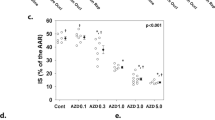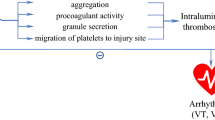Abstract
Myocardial ischemia/reperfusion (I/R) injury is partly mediated by thrombin. In support, the functional inhibition of thrombin has been shown to decrease infarct size after I/R. Several cellular responses to thrombin are mediated by a G-protein coupled protease-activated receptor 1 (PAR1).However, the role of PAR1 in myocardial I/R injury has not been well characterized. Therefore, we hypothesized that PAR1 inhibition will reduce the amount of myocardial I/R injury. After we detected the presence of PAR1 mRNA and protein in the rat heart by RT-PCR and immunoblot analysis,we assessed the potential protective role of SCH 79797, a selective PAR1 antagonist, in two rat models of myocardial I/R injury. SCH 79797 treatment immediately before or during ischemia reduced myocardial necrosis following I/R in the intact rat heart. This response was dose-dependent with the optimal dose being 25 μg/kg IV. Likewise, SCH 79797 treatment before ischemia in the isolated heart model reduced infarct size and increased ventricular recovery following I/R in the isolated heart model with an optimal concentration of 1 μM. This reduction was abolished by a PAR1 selective agonist. SCH 79797-induced resistance to myocardial ischemia was abolished by wortmannin, an inhibitor of PI3 kinase; L-NMA, a NOS inhibitor; and glibenclamide, a nonselective KATP channel blocker. PAR1 activating peptide,wortmannin, L-NMA and glibenclamide alone had no effect on functional recovery or infarct size. A single treatment of SCH 79797 administered prior to or during ischemia confers immediate cardioprotection suggesting a potential therapeutic role of PAR1 antagonist in the treatment of injury resulting from myocardial ischemia and reperfusion.
Similar content being viewed by others
References
Ahn HS, Foster C, Boykow G, Stamford A, Manna M, Graziano M (2000) Inhibition of cellular action of thrombin by N3-cyclopropyl-7-[[4-(1-methylethyl) phenyl]methyl]–7H-pyrrolo [3, 2-f] quinazoline-1,3-diamine (SCH 79797), a nonpeptide thrombin receptor antagonist. Biochem Pharmacol 60:1425–1434
Andrade-Gordon P, Derian CK, Maryanoff BE, Zhang HC, Addo MF, Cheung W, Damiano BP,D'Andrea MR, Darrow AL, de Garavilla L, Eckardt AJ, Giardino EC, Haertlein BJ, McComsey DF (2001) Administration of a potent antagonist of protease-activated receptor- 1 (PAR-1) attenuates vascular restenosis following balloon angioplasty in rats. J Pharmacol Exp Ther 298:34–42
Baker JE, Holman P, Gross GJ (1999) Preconditioning in immature rabbit hearts: role of KATP channels. Circulation 99:1249–1254
Baker JE,Konorev EA,Gross GJ,Chilian WM,Jacob HJ (2000) Resistance to myocardial ischemia in five rat strains: is there a genetic component of cardioprotection? Am J Physiol Heart Circ Physiol 278:H1395–H1400
Cai Z, Semenza GL (2004) Phosphatidylinositol- 3-kinase signaling is required for erythropoietin-mediated acute protection against myocardial ischemia/ reperfusion injury. Circulation 109:2050–2053
Chackalamannil S (2003) G-protein coupled receptor antagonists-1: protease activated receptor-1 (PAR-1) antagonists as novel cardiovascular therapeutic agents. Curr Top Med Chem 3:1115–1123
Chong AJ, Pohlman TH, Hampton CR, Shimamoto A,Mackman N,Verrier ED (2003) Tissue factor and thrombin mediate myocardial ischemia-reperfusion injury. Ann Thorac Surg 75:S649–S655
Cole WC, McPherson CD, Sontag D (1991) ATP-regulated K+ channels protect the myocardium against ischemia/ reperfusion damage. Circ Res 69:571–581
Coughlin SR (2002) Protease-activated receptors in the cardiovascular system. Cold Spring Harb Symp Quant Biol 67:197–208
D'Andrea MR, Derian CK, Leturcq D, Baker SM, Brunmark A, Ling P, Darrow AL, Santulli RJ, Brass LF,Andrade-Gordon P (1998) Characterization of protease- activated receptor-2 immunoreactivity in normal human tissues. J Histochem Cytochem 46:157–164
Erlich JH, Boyle EM, Labriola J, Kovacich JC, Santucci RA, Fearns C, Morgan EN, Yun W, Luther T, Kojikawa O, Martin TR, Pohlman TH, Verrier ED, Mackman N (2000) Inhibition of the tissue factor-thrombin pathway limits infarct size after myocardial ischemiareperfusion injury by reducing inflammation. Am J Pathol 157:1849–1862
Garlid KD, Paucek P, Yarov-Yarovoy V, Murray HN, Darbenzio RB, DiAlonzo AJ, Lodge NJ, Smith MA, Grover GJ (1997) Cardioprotective effect of diazoxide and its interaction with mitochondrial ATP-sensitive K+ channels. Potential mechanism of cardioprotection. Circ Res 81:1072–1082
Gross GJ,Fryer RM (1999) Sarcolemmal versus mitochondrial ATP-sensitive K+ channels and myocardial preconditioning. Circ Res 84:973–979
Hanley PJ, Daut J (2005) K(ATP) channels and preconditioning: a re-examination of the role of mitochondrial K(ATP) channels and an overview of alternative mechanisms. J Mol Cell Cardiol 39:17–50
Hollenberg MD (1996) Protease-mediated signalling: new paradigms for cell regulation and drug development. Trends Pharmacol Sci 17:3–6
Mirza H, Yatsula V, Bahou WF (1996) The proteinase activated receptor-2 (PAR-2) mediates mitogenic responses in human vascular endothelial cells. J Clin Invest 97:1705–1714
Miyuki K,Tetsuya T, Mitsuo T,Akiko M, Satoshi Y, Jun S, Natsuya K, Satoaki M, Jun A,Masao N (2003) The dual effects of nitric oxide synthase inhibitors on ischemia-reperfusion injury in rat hearts. Basic Research in Cardiology V98:319–328
Much-Ellingsen J, Bugge E, Ytrehus K (1996) Blockade of the KATP-channel by glibenclamide aggravates ischemic injury, and counteracts ischemic preconditioning. Basic Research in Cardiology V91:382–388
Nelken NA, Soifer SJ, O’Keefe J,Vu TK, Charo IF,Coughlin SR (1992) Thrombin receptor expression in normal and atherosclerotic human arteries. J Clin Invest 90:1614–1621
Noma A (1983) ATP-regulated K+ channels in cardiac muscle. Nature 305:147–148
Patel HH, Fryer RM, Gross ER, Bundey RA,Hsu AK, Isbell M,Eusebi LO, Jensen RV, Gullans SR, Insel PA, Nithipatikom K, Gross GJ (2003) 12-lipoxygenase in opioid-induced delayed cardioprotection: gene array, mass spectrometric, and pharmacological analyses. Circ Res 92:676–682
Sabri A,Muske G, Zhang H, Pak E, Darrow A,Andrade-Gordon P, Steinberg SF (2000) Signaling properties and functions of two distinct cardiomyocyte protease-activated receptors. Circ Res 86:1054–1061
Sevastos J, Kennedy SE, Davis DR, Sam M, Peake PW, Charlesworth JA, Mackman N, Erlich JH (2007) Tissue factor deficiency and PAR-1 deficiency are protective against renal ischemia reperfusion injury. Blood 109:577–583
Rohatgi T, Henrick-Noack P, Sedehizade F,Goertler M,Wallesch CW,Reyman KG,Reiser G (2004) Transient focal ischemia in rat brain differentially regulates mRNA expression of proteaseactivated receptors 1 to 4. J Neuroscience Res 75:273–279
Vu TK HD, Wheaten VI, Coughlin SR (1991) Molecular cloning of a functional thrombin receptor reveals a novel proteolytic mechanism of receptor activation. Cell 64:1057–1068
Author information
Authors and Affiliations
Corresponding author
Additional information
The studies described were supported in part by NIH grants HL54075 (JEB) and HL0831 (GJG). JLS is supported by an NIH training grant (HL07792) awarded to the Medical College of Wisconsin.
Rights and permissions
About this article
Cite this article
Strande, J.L., Hsu, A., Su, J. et al. SCH 79797, a selective PAR1 antagonist, limits myocardial ischemia/reperfusion injury in rat hearts. Basic Res Cardiol 102, 350–358 (2007). https://doi.org/10.1007/s00395-007-0653-4
Received:
Revised:
Accepted:
Published:
Issue Date:
DOI: https://doi.org/10.1007/s00395-007-0653-4




